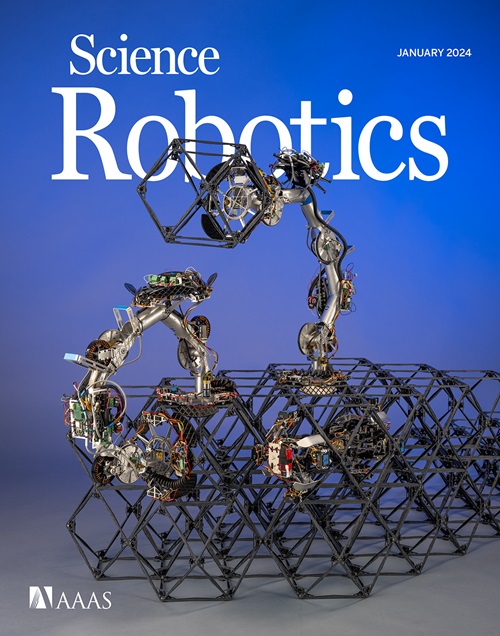反事实奖励促进使用个体控制的群体微型机器人进行集体运输
IF 27.5
1区 计算机科学
Q1 ROBOTICS
引用次数: 0
摘要
群机器人提供了令人着迷的机会来执行超出单个机器能力的复杂任务。就像一群蚂蚁集体移动大型物体一样,一组机器人也可以通过基于局部感知的个体策略来实现类似的功能。然而,单独控制的微机器人实现集体功能尤其具有挑战性,因为它们的微米尺寸,大量的自由度,相对于推进速度的强热噪声,以及相邻微机器人之间复杂的物理耦合。在这里,我们实现了多智能体强化学习(MARL),以生成多达200个微型机器人的控制策略,这些机器人的运动由激光点单独控制。在学习过程中,我们使用所谓的反事实奖励,自动将学分分配给单个微型机器人,这使得快速和公正的训练成为可能。在这种有效的奖励机制的帮助下,群体微型机器人学会集体运输一个大型货物物体到任意位置和方向,类似于蚁群。我们表明,这种灵活和通用的群体机器人系统对群体规模的变化、故障单元的存在和环境噪声具有鲁棒性。此外,在演示实验中,我们让机器人群同时操纵多个物体,突出了分布式控制和独立微机器人运动的好处。像我们这样的控制策略可以潜在地实现移动微机器,可编程药物输送胶囊和其他先进的芯片实验室应用的复杂和自动化组装。本文章由计算机程序翻译,如有差异,请以英文原文为准。
Counterfactual rewards promote collective transport using individually controlled swarm microrobots
Swarm robots offer fascinating opportunities to perform complex tasks beyond the capabilities of individual machines. Just as a swarm of ants collectively moves large objects, similar functions can emerge within a group of robots through individual strategies based on local sensing. However, realizing collective functions with individually controlled microrobots is particularly challenging because of their micrometer size, large number of degrees of freedom, strong thermal noise relative to the propulsion speed, and complex physical coupling between neighboring microrobots. Here, we implemented multiagent reinforcement learning (MARL) to generate a control strategy for up to 200 microrobots whose motions are individually controlled by laser spots. During the learning process, we used so-called counterfactual rewards that automatically assign credit to the individual microrobots, which allows fast and unbiased training. With the help of this efficient reward scheme, swarm microrobots learn to collectively transport a large cargo object to an arbitrary position and orientation, similar to ant swarms. We show that this flexible and versatile swarm robotic system is robust to variations in group size, the presence of malfunctioning units, and environmental noise. In addition, we let the robot swarms manipulate multiple objects simultaneously in a demonstration experiment, highlighting the benefits of distributed control and independent microrobot motion. Control strategies such as ours can potentially enable complex and automated assembly of mobile micromachines, programmable drug delivery capsules, and other advanced lab-on-a-chip applications.
求助全文
通过发布文献求助,成功后即可免费获取论文全文。
去求助
来源期刊

Science Robotics
Mathematics-Control and Optimization
CiteScore
30.60
自引率
2.80%
发文量
83
期刊介绍:
Science Robotics publishes original, peer-reviewed, science- or engineering-based research articles that advance the field of robotics. The journal also features editor-commissioned Reviews. An international team of academic editors holds Science Robotics articles to the same high-quality standard that is the hallmark of the Science family of journals.
Sub-topics include: actuators, advanced materials, artificial Intelligence, autonomous vehicles, bio-inspired design, exoskeletons, fabrication, field robotics, human-robot interaction, humanoids, industrial robotics, kinematics, machine learning, material science, medical technology, motion planning and control, micro- and nano-robotics, multi-robot control, sensors, service robotics, social and ethical issues, soft robotics, and space, planetary and undersea exploration.
 求助内容:
求助内容: 应助结果提醒方式:
应助结果提醒方式:


